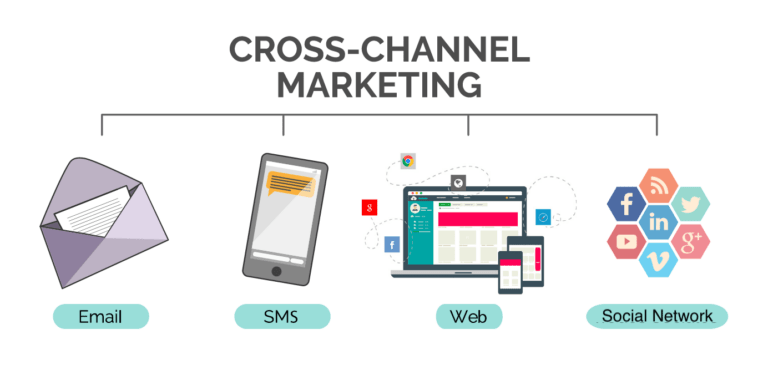- May 26, 2025
- by Parbeshkumar Maurya
Beyond Email — How to Integrate SMS, Push, and In-App for Cross-channel Truly Seamless Engagement | Omni-Channel Growth Series Blog 5
Let’s be honest — life moves faster than ever.
One minute your customer’s browsing your website on their laptop. Next, they’re checking your app while waiting for a coffee. An hour later, they’re responding to a text notification you sent. By the evening, they’re clearing their cluttered email inbox.
In a world where people juggle devices, channels, and attention spans without even thinking about it, relying on just email to stay connected is like trying to run a marathon wearing flip-flops.
If you’re not stitching together these touchpoints, you’re not just missing sales—you’re missing relationships.
Welcome to the next level of customer engagement: coordinating Email, SMS, Push Notifications, and In-App Messaging to create one continuous, human conversation.
In Blog 5 of our Growlytics Omni-Channel Series, we’re diving deep into how to build cross-channel messaging that feels natural—not noisy.
Why Email Alone Can’t Carry the Conversation Anymore
Sure, email’s not dead. In fact, it’s still one of the best channels for storytelling, education, and long-form communication.
But here’s the thing: email is slow.
Today’s customers are conditioned for real-time responses. They expect brands to know when they’re interested, when they’re ready to buy, when they need a gentle nudge. They don’t want to wait hours—or worse, days—for that email to land.
According to Salesforce’s Connected Customer Report:
- 76% of customers expect seamless interactions across all communication channels.
- 73% are more likely to engage when brands communicate across multiple touchpoints in sync.
If you’re banking on email alone, you’re not in the conversation when it matters most.
Building the New Communication Ecosystem: It’s Not Just About More, It’s About Smarter
When you think about modern engagement, think in layers, not silos.
Here’s what each channel brings to the table:
- 📩 Email — For rich stories, onboarding sequences, post-purchase follow-up.
- 📱 SMS — For urgent updates, flash sales, appointment reminders.
- 🔔 Push Notifications — For quick nudges when customers drift away.
- 📲 In-App Messages — For contextual nudges when customers are already inside your app.
- 📣 Social Media (Instagram, Facebook, WhatsApp, etc.) — For community engagement, DM campaigns, retargeting, and conversational commerce.
The trick isn’t to bombard customers everywhere. It’s to make each interaction feel logical, welcome, and connected to their journey.

A Real-World Example: When Brands Get It Right
Picture this: You download a health app called MoveWell. You browse a few fitness plans but don’t commit right away.
Here’s what happens next:
- Two hours later, you get a push notification: “Still considering your fitness journey? Your perfect plan awaits!”
- The next morning, an SMS pops up offering 20% off that plan if you act today.
- Later, an email arrives, showcasing customer stories about how the plan transformed their fitness.
- When you open the app again, an in-app message gently welcomes you back and offers a bonus one-on-one coaching session if you subscribe.
Every message feels connected, like the brand actually remembers you—not like four different departments are spamming you randomly.
MoveWell’s cross-channel strategy boosted their conversion rates by 29% compared to email-only campaigns.
How to Craft a Seamless Cross-Channel Messaging Strategy
It’s not magic. It’s smart orchestration, built step-by-step:
Step 1: Unite Your Data
If your web, app, email, and SMS tools don’t talk to each other, your customer experiences won’t either. Invest in a Customer Data Platform (CDP) or robust CRM to pull everything into one view.
Think: one customer profile across every channel, not five different versions.
Step 2: Choose the Right Moment, the Right Message, the Right Channel
Not every moment deserves an email.
Not every nudge needs a text.
- Push when immediacy matters (abandoned carts, product updates).
- SMS when urgency matters (flash sales, last-chance reminders).
- In-App when opportunity matters (rewards, onboarding, upsells).
- Email when storytelling matters (newsletters, educational content, lifecycle nurturing).
- Social media platforms like Instagram, Facebook, and WhatsApp are increasingly becoming critical for brand-consumer conversations. ( social is no longer just for awareness—it’s now part of the engagement layer.)
Step 3: Personalize Like a Human, Not a Robot
Every message should feel like it was crafted for that individual, based on what they did, what they browsed, what they cared about—not just their first name.
AI can help automate personalization, but empathy and timing still win hearts.
The Non-Negotiables for Cross-Channel Excellence
✅ Respect the Customer’s Pace: Don’t overwhelm them. Sequence your communications logically.
✅ Speak With One Voice: Whether it’s SMS, push, email, or in-app, your tone and branding should feel consistent.
✅ Listen and Adapt: Let customers tell you how they want to communicate—and honor their choices.
✅ Measure the Journey, Not Just Channels: Success isn’t just about open rates or clicks—it’s about how customers move through the entire journey.
Conclusion: Customers Aren’t Thinking in Channels—They’re Living Their Lives
They aren’t walking around saying, “Now I’m checking my email, now I’m opening an app, now I’m reading a text.” They’re just living—and they expect brands to keep up.
The brands that win tomorrow are the ones that connect today—not by shouting louder, but by orchestrating smarter conversations across every touchpoint.
Ready to humanize your cross-channel strategy and make every message count?
Next in Our Omni-Channel Series:
📢Blog 6: Measuring Omni-Channel Success: KPIs That Actually Matter.
